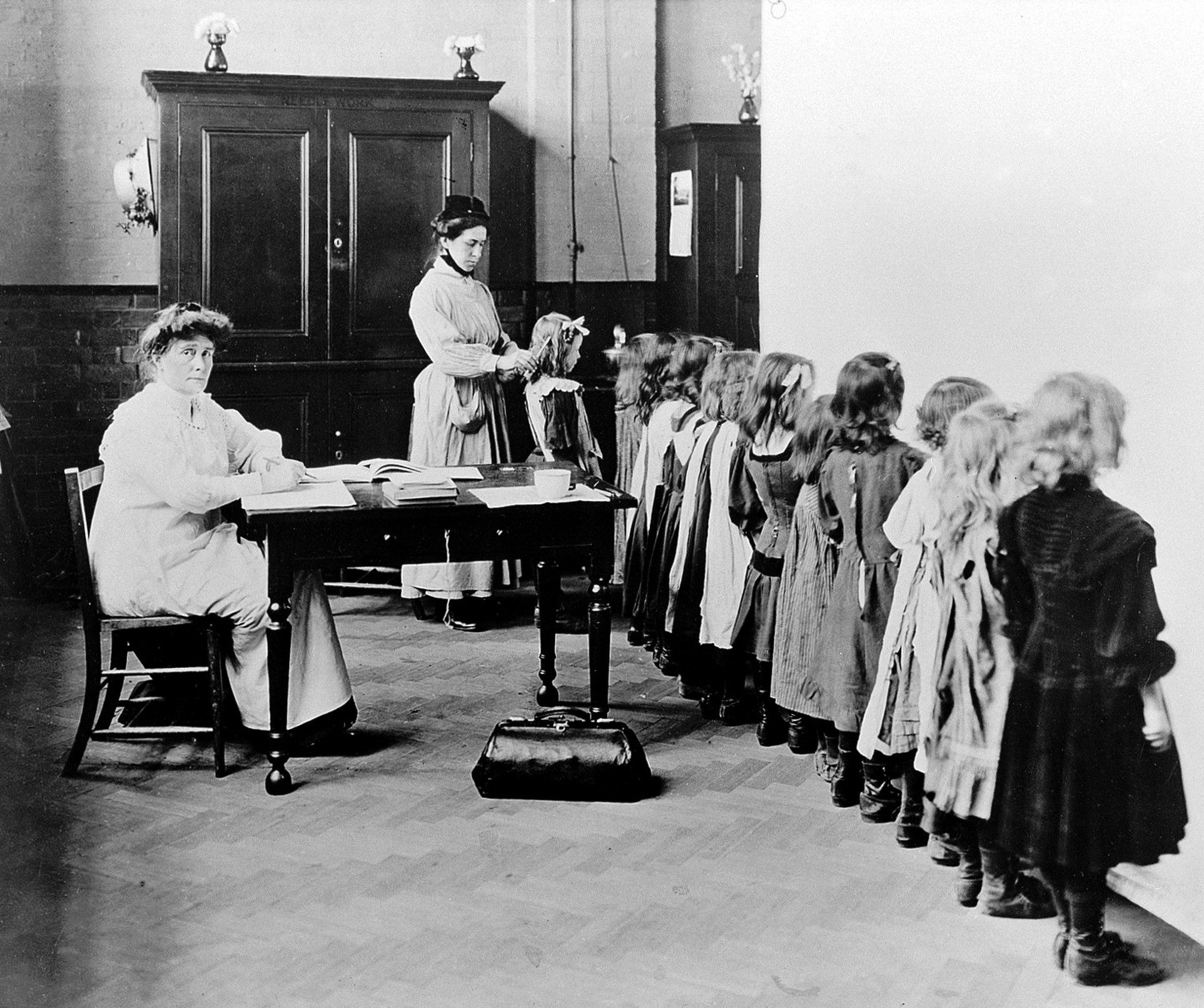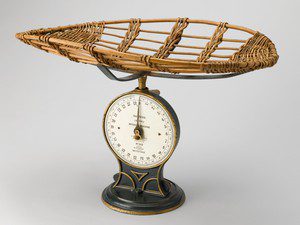
May 7, 2020, by Richard Bates
Where was Florence Nightingale?: Developing Municipal Health Visiting After 1900
This piece by Dr Pamela Dale, honorary fellow at the University of Exeter, looks at the development of health visiting at a municipal level after 1900. This blog is drawn from Pamela’s ongoing research – if you have information that could help her, do get in touch!
[Image: Woman Sanitary Inspector examining young girls’ hair, no date. Wellcome Collection]
Today health visiting is an elite branch of nursing: only registered nurses and midwives can train as health visitors. Nurses have dominated the profession for the last 100 years, and the histories of nursing and health visiting are closely linked. However, some alternative models of health visitors were also promoted in the pioneering phase. The first health visitors employed in Edwardian Bradford, for example, were Female Sanitary Inspectors who had certificates from the Royal Sanitary Institute as well as nursing experience. Before World War I, Huddersfield recruited women doctors to act as health visitors. Uncertainty about who to appoint also extended to what staff could and should do.
Florence Nightingale, a passionate believer in health education, made important contributions to the development of health visiting, drawing an important distinction between treating and preventing sickness. Generations of health visitors have been inspired by her professional ideals. Reviews of the profession, such as that by Cheryll Adams in 2012, regularly draw on Nightingale’s writings. Critics of the health visiting profession have also extensively quoted Nightingale. Now, as much as ever, there is interest among health visitors in Nightingale’s personal life, career, and legacy.
Nightingale’s complex personality forms part of the analysis: love her or loathe her, she is hard to escape. There was, however, a period when she went missing. Between 1900 and 1914 – the years leading up to and following Nightingale death in 1910 – many local authorities appointed health visitors for the first time. They gave many reasons for this – but I have found no mention of Florence Nightingale among them. Her name seems entirely absent from local records.
Defining the Health Visitor role in Halifax
In the early years of the twentieth century, local health departments were led by Medical Officers of Health (MOsH). These doctors tended to credit their medical colleagues with key reforms, and their records suggest no engagement with nurses or nursing organisations at a local or national level.
Halifax Corporation, whose records I have examined in some detail, prided itself on being a progressive local authority. In 1902, councillors and officials considered appointing a health visitor, but failed to act. They could not agree on what the job involved and who should undertake it – other than that it should be a woman. Using one of Nightingale’s classic tactics, the Corporation set out to learn more by devising a questionnaire, which they circulated to more than 70 councils in 1907. The Halifax group wanted to know what kinds of people other councils employed as health visitors, what tasks they undertook, and what impact the service had.
To the apparent surprise of the Halifax MOH, the results showed that there was a large number and variety of schemes in operation. Some health visiting staff were trained nurses, but others had a range of alternative qualifications, including certificates from the Royal Sanitary Institute. Several responses argued against appointing women with medical degrees for these roles, without giving any particular explanation – nor was there any analysis or justification of the connection between nursing and health visiting. Most replies were enthusiastic about the benefits of health visiting. However, since some of the services were new the emphasis was on potential rather than documented results. Several councils reported plans to expand their team in the near future.

Infant weighing machine c.1890-1930, London. Wellcome Collection, CC BY 4.0
Impressed by the many examples they received, Halifax Corporation started a recruitment process, resulting in the appointment of a single health visitor, Mary Watson Wayne (replaced after 6 months by Alice Thompson), supported by a team of women volunteers. This statutory-voluntary sector partnership had mixed results when in operation before and during World War I (1908-1918), but Thompson and her staff were widely respected. Her deputy and eventual successor Elsie Oram gained something of a national reputation in the interwar years, but the relationship between nursing and health visiting remained uncertain. The Maternity and Child Welfare Act (1918) aimed to standardise services. Nursing gradually became the main, and then the only approved route into municipal health visiting. Places like Exeter, which had started their health visiting service later (1916) than Halifax and always relied on nurses, managed these changes better. Exeter City Council records reveal none of the anxiety about appointments shown in Halifax. Councillors and officials seemed confident from the outset that they knew who a health visitor was and what she should do.
Returning to Nightingale
However, operating the service proved complicated in practice. Problems of staff recruitment and retention persisted in both Exeter and Halifax throughout my study period (1906-1974). Problems with role conflict and role confusion were always apparent in local records. By the 1970s these topics were central to contemporary as well as historical accounts of health visiting. Supporters and critics of the profession covered similar ground but reached few definite conclusions.
It was at this stage that nurses and non-nurses started to draw heavily on Nightingale’s work. Her writings, especially the emphasis on selfless vocation, created opportunities to explore the high ideals of the health visiting service over many decades. This was important when practitioners in the 1970s and 1980s were struggling with negative publicity resulting from major child abuse inquiries.
For some, Nightingale’s complex personality provided insights into the dilemmas of health visiting past and present. In their 2003 book The Social Construction of Community Nursing, Anne Kelly and Anthea Symonds argued that while Nightingale’s contribution to the history of the profession is undisputed, her legacy is more problematic. Kelly and Symonds suggested that the twenty-first-century profession needs to both celebrate the ideas of Florence Nightingale and move on – and they are by no means the only authors to do so.
But if Nightingale remains central to debates about the nature of the health visiting profession today, why was she absent from the same debates in the Edwardian period, when she was still alive? In part the explanation is that the crucial local records were created by doctors, and MOsH became aware of health visiting schemes through conference papers and publications created by doctors writing for doctors. Nurses didn’t get a look in: the MOsH generally did not mention organisations representing nurses and/or health visitors and did not seek their advice and opinions. The work of local MOsH was also severely constrained by the demands of the Local Government Board and later the Ministry of Health. Edicts from Whitehall conveyed the thinking of politicians, civil servants and government medical officers – but offered no ideas from, or contacts with nurses or nursing organisations. Nurses and health visitors were both somewhat excluded from official discourse, and at this time they were often rival groups. It was only later that health visitors became more comfortable with their identity as nurses and health visitors, and that the maturing profession of health visiting found value in publicly debating Nightingale’s life and legacy as a guide to future as well as past practice.
Can you help research this topic?
Our understanding of the profession remains limited by gaps in the literature. The attention given to health visiting at different times and in different places varies. While staffing issues have been studied little is known about individual practitioners. However, we can learn more from a variety of sources. I would be interested to hear from anyone with information about early-twentieth-century health visitors. It would be particularly helpful to source documents that link pioneer staff to the work of Florence Nightingale.
Dr Pamela Dale can be contacted via her University of Exeter email.
This blog draws on research that was generously supported by the Wellcome Trust, grant O74999.
References / Further Reading
Adams, C. (2012), A paper on the History of Health Visiting, https://ihv.org.uk/about-us/history-of-health-visiting/a-paper-by-cheryll-adams/.
Dale, P. (2020), ‘The contested appointment of the first Halifax health visitor: exploring the importance of local as well as national debates in the Edwardian infant welfare movement’, Transactions of the Halifax Antiquarian Society.
Dale, P. (2020), ‘Health visiting between the wars: using fragmentary biographical data to explore attempts to resolve a developing recruitment and retention crisis’, UKAHN Bulletin, 8 (1).
Dingwall, R., Rafferty, A. M., and Webster, C. (1988), An Introduction to the Social History of Nursing (London: Routledge), chapter 9.
Kelly, A., and Symonds, A. (2003), The Social Construction of Community Nursing (Basingstoke: Palgrave Macmillan).
No comments yet, fill out a comment to be the first

Leave a Reply